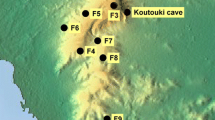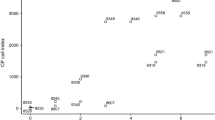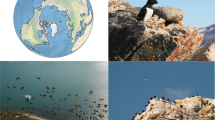Abstract
Digital acoustic recording devices allow for recording of vocal activity of animals over long time periods and therefore open new perspectives for monitoring. In this paper results of a bioacoustic monitoring of birds in a wetland restoration area in Mecklenburg-Western Pomerania in Northeastern Germany are presented. Ninety minutes of sound recordings were made daily from March 29 until May 30 2012 using a four-channel recording setup. The recording schedule was mainly designed for nocturnal birds but also included dawn and dusk choruses. By listening to the recordings, supported by spectrographic visualization, 61 bird species could be detected. Despite the fact that most of the recordings were made during the night, no period of absolute silence was detected. The occurrence data allow some conclusions on the state of the bird species, e.g., breeding bird, resting during migration, or guest only. The bioacoustic monitoring revealed the occurrence of rare nocturnal birds such as Little Crake (Porzana parva), Spotted Crake (Porzana porzana) and Short-eared Owl (Asio flammeus). For the Eurasian Bittern (Botaurus stellaris) data on vocal activity and population size could be obtained. The study has shown that automated acoustic recordings can be applied for long-term monitoring of bird populations in remote areas.
Zusammenfassung
Informationsgehalt akustischer Langzeitaufzeich-nungen: Anwendung bioakustischer Verfahren zum Monitoring von Vögeln in Feuchtgebieten während der Brutzeit
Digitale Aufzeichnungsgeräte erlauben, die Lautaktivität von Tieren über lange Zeiträume aufzuzeichnen, und eröffnen damit neue Möglichkeiten für Monitoringaufgaben. Im vorliegenden Beitrag werden die Ergebnisse eines bioakustischen Monitorings von Vögeln in einem Moor-Renaturierungsgebiet in Mecklenburg-Vorpommern erörtert. Vom 29. März bis 30. Mai 2012 wurden mit einem Vierkanalrecorder täglich 90 Minuten aufgezeichnet. Das Aufzeichnungsregime war auf die Erfassung von nachtaktiven Vögeln ausgerichtet, schloss aber das morgendliche und abendliche Vogelkonzert auch mit ein. Durch ein durch spektrographische Visualisierung unterstütztes Abhören der Tonaufzeichnungen wurden insgesamt 61 Vogelarten festgestellt. Ungeachtet des Umstandes, dass die meisten Aufnahmen nachts gemacht wurden, war auf keiner Aufnahme wirkliche Stille zu vernehmen. Die Nachweise auf den Tonaufzeichnungen ermöglichten, den Status der Vogelart einzuschätzen, ob es sich um wahrscheinliche Brutvögel, rastende Tiere oder Nahrungsgäste handelte. Das akustische Monitoring erbrachte Nachweise seltener nachtaktiver Vogelarten wie Kleines Sumpfhuhn (Porzana parva), Tüpfelsumpfhuhn (Porzana porzana) und Sumpfohreule (Asio flammeus). Für die Rohrdommel (Botaurus stellaris) konnten auf akustischem Weg Daten zu Rufaktivität und Bestandsgröße erhoben werden. Die Studie hat gezeigt, dass automatische akustische Aufzeichnungen für ein Monitoring von Vogelpopulationen in schwer zugänglichen Gebieten gut geeignet sind.







Similar content being viewed by others
References
Acevedo MA, Villanueva-Rivera LJ (2006) Using automated digital recording systems as effective tools for the monitoring of birds and amphibians. Wildlife Soc B 34:211–214. doi:10.2193/0091-7648(2006)34[211:UADRSA]2.0.CO;2
Bardeli R, Wolff D, Kurth F, Koch M, Tauchert K-H, Frommolt K-H (2010) Detecting bird sounds in a complex acoustic environment and application to bioacoustic monitoring. Pattern Recogn Lett 31:1524–1534. doi:10.1016/j.patrec.2009.09.014
Bibby C, Burgess N, Hill D, Mustoe S (2000) Bird census techniques, 2nd edn. Academic, London
Blumstein DT, Mennill DJ, Clemins P, Girod L, Yao K, Patricelli G, Deppe JL, Krakauer AH, Clark CW, Cortopassi KA, Hanser SF, McCowan B, Ali AM, Kirschel ANG (2011) Acoustic monitoring in terrestrial environments using microphone arrays: applications, technological considerations and prospectus. J Appl Ecol 48:758–767. doi:10.1111/j.1365-2664.2011.01993.x
Boucher N, Jinnai M, Smolders A (2012) A fully automatic acoustic monitor and survey system. In: Proceedings of the acoustics 2012 Nantes conference, 23–27 April 2012, Nantes, pp 2455–2461
Buckland ST (2006) Point-transect surveys for songbirds: robust methodologies. Auk 123:345–357. doi:10.1642/0004-8038(2006)123[345:PSFSRM]2.0.CO;2
Budka M, Wojas L, Osiejuk TS (2015) Is it possible to acoustically identify individuals within a population. J Ornithol 156:481–488. doi:10.1007/s10336-014-1149-2
Catchpole CK, Slater PJB (1995) Bord song. Biological themes and variations. University Press, Cambridge
Celis-Murillo A, Deppe JL, Allen MF (2009) Using soundscape recordings to estimate bird species abundance, richness, and composition. J Field Ornithol 80(1):64–78
Dawson DK, Efford MG (2009) Bird population density estimated from acoustic signals. J Appl Ecol 46:1201–1209. doi:10.1111/j.1365-2664.2009.01731.x
Espmark YO, Lampe HM (1993) Variations in the song of the pied flycatcher within and between breeding seasons. Bioacoustics 5:33–65
Farnsworth A, Gauthreaux SA, van Blaricom D (2004) A comparison of nocturnal call counts of migrating birds and reflectivity measurements on Doppler radar. J Avian Biol 35:365–369
Fristrup KM, Mennitt D (2012) Bioacoustical monitoring in terrestrial environments. Acoust Today 3:16–24
Frommolt K-H (2013) Akustische Mustererkennung von Tierstimmen und deren Nutzung für Monitoringaufgaben im Interesse des Naturschutzes. Lect Notes Inf P-220:2880–2891
Frommolt K-H, Tauchert K-H (2014) Applying bioacoustic methods for long-term monitoring of a nocturnal wetland bird. Ecol Inform 21:4–12. doi:10.1016/j.ecoinf.2013.12.009
Graber RR, Cochran WW (1959) An audio technique for the study of nocturnal migration of birds. Wilson Bull 71:220–236
Gregory RD, Gibbons DW, Donald PF (2004) Bird census and survey techniques. In: Sutherland WJ, Newton I, Green RE (eds) Bird ecology and conservation; a handbook of techniques. Oxford University Press, Oxford, pp 17–56
Haselmayer J, Quinn JS (2000) A comparison of point counts and sound recording as bird survey methods in Amazonian southeast Peru. Condor 102:887–893
Herold B (2012) Neues Leben in alten Mooren. Brutvögel wiedervernässter Flusstalmoore, Haupt, Bern, Stuttgart, Wien
Hildebrand JA, Baumann-Pickering S, Frasier KE, Trickey JS, Merkens KP, Wiggins SM, McDonald MA, Garrison LP, Harris D, Marques TA, Thomas L (2015) Passive acoustic monitoring of beaked whale densities in the Gulf of Mexico. Sci Rep 5:16343. doi:10.1038/srep16343
Hilje B, Aide TM (2012a) Calling activity of the common tink frog (Diasporus diastema) (Eleutherodactylidae) in secondary forests of the Caribbean of Costa Rica. Trop Conserv Sci 5:2012
Hilje B, Aide TM (2012b) Recovery of amphibian species richness and composition in a chronosequence of secondary forests, northeastern Costa Rica. Biol Conserv 146:170–176
Hobson KA, Rempel RS, Greenwood H, Turnbull B, van Wilgenburg SL (2002) Acoustic surveys of bird using electronic recordings. New potential from an omnidirectional microphone system. Wildlife Soc B 30:709–720
Hüppop O, Hilgerloh G (2012) Flight call rates of migrating thrushes: effects of wind conditions, humidity and time of day at an illuminated offshore platform. J Avian Biol 43:85–90
Hutto RL, Stutzman RJ (2009) Humans versus autonomous recording units: a comparison of point-count results. J Field Ornithol 80:387–398
Lasseck M (2015) Towards automatic large-scale identification of birds in audio recordings. In: Mothe J et al (eds) Experimental IR meets multilinguality, multimodality, and interaction. Springer, Cham, pp 364–375. doi:10.1007/978-3-319-24027-5_39
MLUV MV (2009) Konzept zum Schutz und zur Nutzung der Moore. Fortschreibung des Konzeptes zur Bestandssicherung und zur Entwicklung der Moore, Landesamt für innere Verwaltung Mecklenburg-Vorpommern, Schwerin
Nemeth E (1996) Different singing styles in mated and unmated reed buntings Emberiza schoeniclus. Ibis 138:172–176. doi:10.1111/j.1474-919X.1996.tb04325.x
QUT (2016) Ecosounds. https://ecosounds.org/website_status. Accessed 1 June 2016
Sieve Analytics (2015) Arbimon. https://arbimon.sieve-analytics.com/project/perm-stations/dashboard. Accessed 1 June 2016
Steer J (2010) Bioacoustic monitoring of New Zealand birds. Notornis 57:75–80
Stowell D, Plumbley MD (2014) Automatic large-scale classification of bird sounds is strongly improved by unsupervised feature learning. PeerJ 2:e488. doi:10.7717/peerj.488
Swiston KA, Mennill DJ (2009) Comparison of manual and automated methods for identifying target sounds in audio recordings of pileated, pale-pilled, and putative ivory-billed woodpeckers. J Field Ornithol 80:42–50
Terry AMR, Peake TM, McGregor PK (2005) The role of vocal individuality in conservation. Front Zool 2:10. doi:10.1186/1742-9994-2-10
Thompson ME, Schwager SJ, Payne KB, Turkalo AK (2009) Acoustic estimation of wildlife abundance: methodology for vocal mammals in forest habitats. Afr J Ecol 48:654–661
Towsey M, Planitz B, Nantes A, Wimmer J, Roe P (2012) A toolbox for animal call recognition. Bioacoustics 21:107–125
Venier LA, Holmes SB, Holborn GW, McIlwrick KA, Brown G (2013) Evaluation of an automated recording device for monitoring forest birds. Wildlife Soc B 36:30–39
Vökler F, Heinze B, Sellin D, Zimmermann H (2014) Rote Liste der Brutvögel Mecklenburg-Vorpommerns. Umweltministerium Mecklenburg-Vorpommern, Schwerin
Wimmer J, Towsey M, Roe P, Williamson I (2013) Sampling environmental acoustic recordings to determine bird species richness. Ecol Appl 23:1419–1428
Acknowledgements
The continuous bioacoustic recording at the Polder Große Rosin is realized in cooperation between the association of the “Naturpark Mecklenburgische Schweiz und Kummerower See” and the Museum für Naturkunde Berlin. The project is funded by the “Norddeutschen Stiftung für Umwelt und Entwicklung”. Special thanks to Dietmar Schriever who built the metallic construction of the recording unit. I am grateful to Wolfgang Wiehle, Gerald Lordan, Dietmar Frömdling and Dagmar Langrock for assistance during field work. Thanks to David Lazarus for language support and the reviewers for helpful comments.
Author information
Authors and Affiliations
Corresponding author
Additional information
Communicated by M. Naguib.
Electronic supplementary material
Below is the link to the electronic supplementary material.
Rights and permissions
About this article
Cite this article
Frommolt, KH. Information obtained from long-term acoustic recordings: applying bioacoustic techniques for monitoring wetland birds during breeding season. J Ornithol 158, 659–668 (2017). https://doi.org/10.1007/s10336-016-1426-3
Received:
Revised:
Accepted:
Published:
Issue Date:
DOI: https://doi.org/10.1007/s10336-016-1426-3




